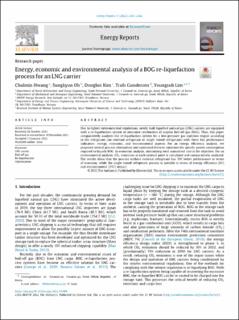| dc.contributor.author | Hwang, Chulmin | |
| dc.contributor.author | Oh, Sungkyun | |
| dc.contributor.author | Kim, Donghoi | |
| dc.contributor.author | Gundersen, Truls | |
| dc.contributor.author | Lim, Yongsub | |
| dc.date.accessioned | 2022-11-18T07:25:09Z | |
| dc.date.available | 2022-11-18T07:25:09Z | |
| dc.date.created | 2022-02-14T15:34:03Z | |
| dc.date.issued | 2022 | |
| dc.identifier.citation | Energy Reports. 2022, 8, 2351-2362. | en_US |
| dc.identifier.issn | 2352-4847 | |
| dc.identifier.uri | https://hdl.handle.net/11250/3032685 | |
| dc.description.abstract | Due to tighter environmental regulations, newly built liquefied natural gas (LNG) carriers are equipped with a re-liquefaction system to minimize combustion of surplus boil-off-gas (BOG). Thus, this paper comparatively analyzes the re-liquefaction system for a low-pressure gas injection engine according to the refrigerant (no external refrigerant or single mixed refrigerant) with three key performance indicators: energy, economic, and environmental aspects. For an energy efficiency analysis, we proposed several process alternatives and optimized them to minimize the specific power consumption required to liquefy BOG. In economic analysis, minimizing total annualized cost is the objective. For an environmental analysis, CO2 emissions at each optimal point is calculated and comparatively analyzed. The results show that the process without external refrigerant has 10% better performance in terms of economy, while the single mixed refrigerant process is suitable in terms of energy efficiency (6%) and environmental (15%) impact. | en_US |
| dc.description.abstract | Energy, economic and environmental analysis of a BOG re-liquefaction process for an LNG carrier | en_US |
| dc.language.iso | eng | en_US |
| dc.publisher | Elsevier Science | en_US |
| dc.rights | Navngivelse 4.0 Internasjonal | * |
| dc.rights.uri | http://creativecommons.org/licenses/by/4.0/deed.no | * |
| dc.title | Energy, economic and environmental analysis of a BOG re-liquefaction process for an LNG carrier | en_US |
| dc.title.alternative | Energy, economic and environmental analysis of a BOG re-liquefaction process for an LNG carrier | en_US |
| dc.type | Peer reviewed | en_US |
| dc.type | Journal article | en_US |
| dc.description.version | publishedVersion | en_US |
| dc.source.pagenumber | 2351-2362 | en_US |
| dc.source.volume | 8 | en_US |
| dc.source.journal | Energy Reports | en_US |
| dc.identifier.doi | 10.1016/j.egyr.2022.01.098 | |
| dc.identifier.cristin | 2001465 | |
| cristin.ispublished | true | |
| cristin.fulltext | original | |
| cristin.qualitycode | 1 | |

